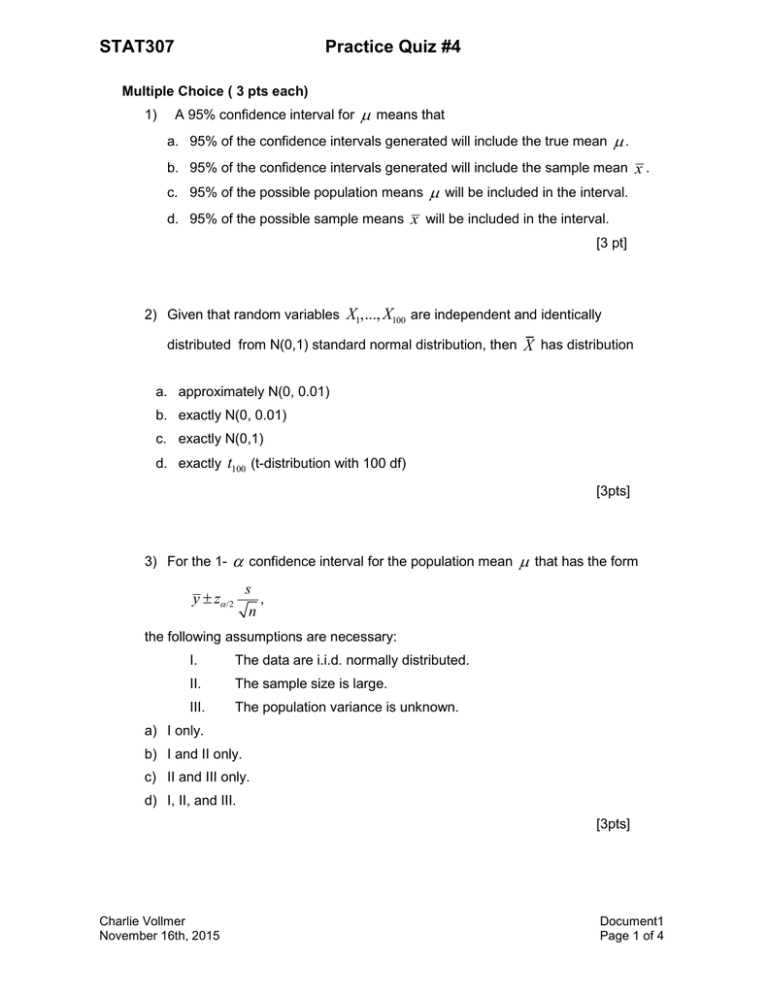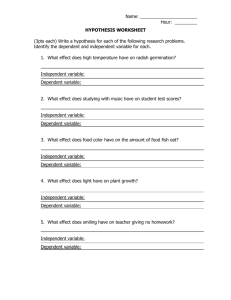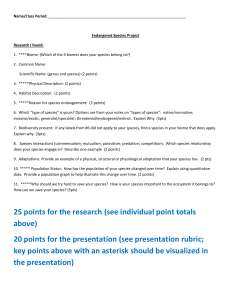right here
advertisement

STAT307 Practice Quiz #4 Multiple Choice ( 3 pts each) 1) A 95% confidence interval for m means that a. 95% of the confidence intervals generated will include the true mean m. b. 95% of the confidence intervals generated will include the sample mean x . c. 95% of the possible population means m will be included in the interval. d. 95% of the possible sample means x will be included in the interval. [3 pt] 2) Given that random variables X1,..., X100 are independent and identically distributed from N(0,1) standard normal distribution, then X has distribution a. approximately N(0, 0.01) b. exactly N(0, 0.01) c. exactly N(0,1) d. exactly t100 (t-distribution with 100 df) [3pts] 3) For the 1- a confidence interval for the population mean m that has the form s , n y ± za /2 the following assumptions are necessary: I. The data are i.i.d. normally distributed. II. The sample size is large. III. The population variance is unknown. a) I only. b) I and II only. c) II and III only. d) I, II, and III. [3pts] Charlie Vollmer November 16th, 2015 Document1 Page 1 of 4 STAT307 Practice Quiz #4 4) Let qˆ be an estimator for the target parameter random variables? q. Which of the following are qˆ I. II. a 90% CI for q III. a pivot quantity for IV. q q a. I only b. II only c. I and II only d. I, II and III [3 pt] 5) The phrase “regression to mediocrity” was coined by: a) William Gosset b) Francis Galton c) Carl Friedrich Gauss d) Thomas Bayes [3pts] (Did any of you read about the firing of Lawrence “Larry” Summers’ position as President of Harvard University; as I suggested in class? --A very interesting interaction between science-statistics-sociology…I do not support his view, per se; I just find it interesting, what occurred.) 6) For a large sample hypothesis test for the population mean H0 : m = 0 Ha : m ¹ 0 if the standardized test statistic comes out to z=1.8 then the p-value is a) 0.0359 b) 0.051 c) 0.0719 d) 0.102 [3pts] Charlie Vollmer November 16th, 2015 Document1 Page 2 of 4 STAT307 Practice Quiz #4 7) A sampling distribution is a) always a normal distribution b) the distribution for a random sample c) the distribution for a satistic d) the distribution for the r.v.’s Y1,...,Yn when they are independent and from the same distribution [3pts] Write a short response to each of the following questions: 1) Define Type I and Type II errors. Give an example where you would prefer making one type of error over the other (and explain why). 2) Define p-value. Why is it often more practical for researchers to include p-values with the reject/not reject conclusions rather than test statistics? 3) What is the advantage of a one-sided test over a two-sided test? Why wouldn’t you always use a two-sided test? Charlie Vollmer November 16th, 2015 Document1 Page 3 of 4 STAT307 Practice Quiz #4 4) What is a statistical reason for being skeptical of findings in medical journals reported with p-values of 0.05? 5) What is the definition of a statistic? Charlie Vollmer November 16th, 2015 Document1 Page 4 of 4


